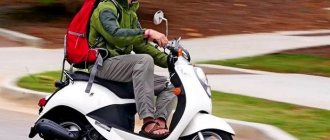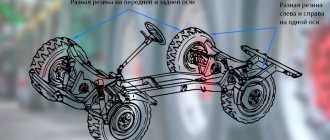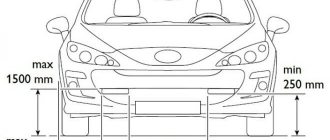Winter and all-season tires in extreme conditions
Let's take a closer look at how tires labeled “All weather” and just winter tires will behave in snowy and icy road conditions.
Let's make a comparison using the example of a Toyota RAV4, with Goodyear Ultra Grip SUV (winter) and Goodyear Vector 4 Seasons G2 (all-season) tires/
| Winter tires (not studded) | All-season tires | |
| 1. Braking distance (at -4°C) | 51 m | 63 m |
| 2. Acceleration (up to 50 km/h) | 3 s | 5.5 s |
| 3. Controllability | · Has good grip and quick steering response · Differs in directional stability · Does not slip and skid on snow and ice | · Grip on slippery roads is difficult to control · At a speed of 40 km/h it starts sliding Reacts slowly when turning the steering wheel |
| 4. Patency | Easily overcomes medium-height snow cover | It's difficult to walk through deep snow and gets stuck on turns. |
As can be seen from the comparison, all-season tires are inferior to winter tires in all respects. They do not provide comfortable and safe movement on slippery surfaces and can lead to the car getting stuck in the snow or getting into an accident.
All-season on snow
The law on winter tires - what is it, has it been adopted and how does it work?
Author: Polina Mustafina - 11/02/2015 So, the “law on winter tires” is, perhaps, an already established expression this year - a new bill providing for the obligation of drivers to drive, relatively speaking, on summer tires in the summer and on winter tires in the winter. The law on winter tires began to be promoted in 2014 and at the end of the year it acquired official status.
As for its status for the current 2021, it has been accepted, it is valid throughout Russia and obliges drivers to drive on winter (or all-season in special cases) tires. But it's not that simple! In recent months, information has increasingly begun to appear in the media about alleged raids by traffic police inspectors to identify drivers of cars with summer tires and charging as much as 5 thousand rubles for summer tires.
And supposedly the law on winter tires provides for liability starting in November of each year. Of course, things are completely different, and let's be clear
Can all-season tires be used in winter?
In 2021, in Russia and Ukraine, the use of all-season tires in winter does not contradict the rules of the road. In this case, the tires must have markings indicating the possibility of their use in winter conditions.
Wheels marked as follows are allowed for use:
- M+S
- M&S
- MS
- Snowflake inside a pictogram in the form of a mountain peak.
Marking M+S
Marking M+S (Mud+Snow) indicates that the tread design allows you to move through mud and snow. The snowflake indicates the possibility of use at subzero temperatures.
The law regulates the minimum tread depth - 4 mm. This applies to cars, SUVs and commercial vehicles.
How do traffic police officers check whether tires are winter or summer?
It's quite simple. Any tire has a marking on the sidewall - you've all seen it. Among other inscriptions and signs, there is also an icon for the seasonality of use of this tire. In particular, winter tires are indicated by a mountain top with 3 peaks and/or the inscription “M+S” or “M•S”.
This is what it looks like:
Thus, if in December, January or February a traffic police inspector stops you, looks at the tires and does not find such markings, then he has the right to issue a fine.
Can you be fined for wearing summer tires in winter?
There is no penalty for summer tires in winter. The Technical Regulations “On the Safety of Wheeled Vehicles” contain clarification about driving in winter. The document requires that the car be “re-shoeed” with studded tires from December 1 to March 1. In Chapter 12 of the Administrative Code, which describes administrative responsibility in the field of road traffic, there is no reference to this paragraph of the regulation, so it should be taken as a recommendation.
Let us clarify in a separate paragraph about Velcro. Cars on all-season tires do not violate the law and there is no fine for them. For the future, keep in mind: if drivers are required to drive “winter” for all three months, “all-season” vehicles labeled “M+S”, “M&S” or “MS” will remain legal.
You can be punished with a ruble for a bald tread if it is less than 1.6 millimeters, and you are driving a passenger car. You will have to pay 500 rubles, but soon the figure may quadruple. Discussions about this began a long time ago, around the same time when it was proposed to fine those who like to ride “in the air” on slippery roads.
To the question “is it possible to drive on summer tires in winter,” we will answer: “depending on the circumstances.” Even if summer tires ended up on your car by accident, and the reasons for the trip are very compelling, it is better to call a tow truck. Winter roads in summer are dangerous even for an experienced driver. Don’t let things get to the point of an accident and it’s better to play it safe. Change tires on time and trust it to professionals. For example, to the craftsmen of the official dealer FAVORIT MOTORS. We do not mix up tires, we screw the wheels tightly, and we also have a box for safe storage of wheels. Convenient and safe.
Penalty for incorrect use of winter or summer tires in 2021
It’s a paradox, but there is simply no monetary punishment that one would have to receive for not having winter tires on a car. There is no reference to this in any legislative document. You can ride the summer version in winter, but this is fraught with the consequences of an accident. A similar fine is already in development, the project already exists, all we have to do is wait. But motorists shouldn’t be complacent about this, because there is another financial penalty – a fine for using worn-out winter tires. Although the amount is small (500 rubles), it causes a lot of trouble. This does not mean that used winter analogues cannot be put on a car. It is possible if the tread depth does not exceed 4 mm. The main condition for imposing a fine is the presence of an icy and snowy road. Otherwise, you can argue with the inspector trying to “hang” these 500 rubles on the condition of the “open road”.
To summarize, several theses can be highlighted.
Firstly, the months from September to November are the period for changing summer tires to winter ones.
Secondly, there is no exact date for replacement; weather conditions must be taken into account. Recommended day: November 15th.
Thirdly, there is no fine for using summer tires in winter, simply because there is no corresponding provision for its imposition yet. But it won't be like this for long.
Advantages and disadvantages of traveling on an all-season vehicle in winter
| Advantages | Flaws |
| 1. Less noise on dry surfaces compared to winter tires 2. Less wheel weight 3. Savings on seasonal changes and the purchase of a second set 4. No need to store a second set of tires | 1. Poor handling, high risk of accidents 2. Chance of getting stuck in snow drifts 3. Long braking distance 4. Heavy acceleration and slipping |
It is advisable to use all-season tires in winter only at average temperatures (not lower than -7°C) and in the absence of high snow cover and icing.
Pros and cons of all-season
How much does the braking distance increase?
The health and life of road users depends on the length of the braking distance. Let's look at how much this indicator differs between all-season tires and winter tires using an example.
| Braking distance on ice | Braking distance on snow | |
| Winter tires (without studs) | 33.5 m | 15.5 m |
| All-season tires | 53.3 m | 22.2 m |
* the initial speed of the car is 50 km/h.
Braking distance largely depends on the car model and the condition of the braking system. But in any case, all-season tires have longer braking times.
What does the Russian traffic rules say?
Since 2015, the technical regulations of the Customs Union “On Security” have been in force on the territory of the Russian Federation (as well as Belarus and Kazakhstan). This document regulates the use of tires in accordance with the time of year. It says the following:
Clause 5.5.
It is prohibited to operate vehicles that are not equipped with winter tires that meet the requirements of paragraph 5.6.3 of this appendix during the winter period (from December to February inclusive). Winter tires are installed on all wheels of the car.
The requirements of paragraph 5.63 are as follows:
5.6.3. The remaining tread height of winter tires intended for use on icy or snowy road surfaces, marked with a snowflake inside a mountain peak with three peaks, as well as the signs “M+S”, “M&S”, “MS” during operation on the specified surface, is no more than 4.0 mm.
It follows from this that all-season tires are allowed in winter in Russia only if the indicated signs are present on them and the tread depth corresponds to the required one.
Tread difference
Is it possible to drive on winter tires in summer and what is the fine?
Apr 26 2021 | Reading time: Using winter tires in summer Open content Driving on winter tires in summer is prohibited. And we are talking specifically about the summer months: June, July and August.
But there are nuances when you can run into a fine for this, and in what cases it can be avoided without losing the increased risk of getting into an accident due to seasonality discrepancies. Now let’s talk about exactly what laws regulate the seasonality of the use of winter and summer tires and what fines are provided for tires that do not correspond to the season. The direct answer to our main question says absolutely nothing useful.
We recommend reading: How to make a temporary registration in Serpukhov
Traffic regulations regulate the condition of tires and wheels, as well as the combination of their use on different axles. But whether it is possible to drive on winter tires in the summer, as well as the possibility of operation, is regulated by the Technical Regulations of the Customs Union “On the Safety of Wheeled Vehicles”.
It is he who prohibits the use in the summer months of tires labeled as winter, but only studded. 5.5.
Driver reviews about using all-season tires in winter
| Positive | Negative |
| The fact that all-season training is dangerous is pure fiction! In Europe everyone rides them. I watched a video where they tested normal quality tires - all-season and winter. As a result, the difference is quite small. The braking distance is a little longer, but knowing your car, you can brake a little in advance. Why overpay for the winter, we are not in the Arctic, the roads are cleaned in the city. | It was all-season from the factory. I thought it was normal until I changed it to winter. Now the car just flies, the steering is perfectly controlled, there are no such brakes. I think that all-season tires are an option for those who simply don’t have the money. If possible, it is better to shell out for two sets. |
| All-season tires are also perfect for mild winters. I bet my wife on Matiz. There is no need to bother and stand in lines to change shoes. They are not very suitable for heavy snow and ice, but she doesn’t drive in such weather. | Is it possible to drive on all-season tires in winter? Of course not. It's not designed for that. I don’t understand those people who drive on such tires in the cold. They risk their health and those around them. I consider such drivers dangerous, they should not only be fined, but immediately put in prison before they kill anyone! |
| For 7 years I have been driving only the Hankuk Optima 4S. I only changed it twice during this time. I am not an extreme driver, I drive very carefully in bad weather conditions, I know how my tires behave in the snow. We have almost no thaws during the winter, so there is no ice on the roads, only compacted snow. The car behaves excellently on this surface. I won’t say anything about ice, I don’t know. | An all-season tire is just a marketing ploy for lazy or greedy people. It's the same as wearing demi-season shoes all year round. It’s bad both in winter and in summer. I was trying to save money. As a result, there were enough tires for 45 thousand. And summer ones are enough for 50. No savings and a health risk! |
| Demi-season tires instead of winter tires are quite suitable for central Russia. Provided that in extreme weather (snowfall, ice) do not drive it. It has lamellas, and the rubber is softer than summer tires. But it is not suitable for summer for one simple reason - it wears off very quickly. | In winter, all-season tires should never be used on our roads. This is pure suicide! Many people say that on Soviet cars there was no such thing as winter-summer. But that was 100 years ago, when there were many things, for example, the Internet. It's stupid to focus on this. Moreover, traffic on the roads has increased significantly. |
*Reviews taken from the sites: www.drive2.ru, motorstory.ru, auto.ria.com, https://davto.com.ua/.
Is it possible to drive in winter on all-season tires?
But is it possible to drive in winter on all-season tires or should you leave this option for an earlier period, for example, in October or November? Yes, all-season tires are universal, and this is their main advantage. But such an excellent compromise to winter tires has several significant drawbacks that every motorist should be aware of before installing tires on their car.
Naturally, all-season tires are cheaper than even the most standard winter options. In terms of price, they can be comparable to summer tires. If we talk about the disadvantages, then first of all it is worth remembering that such tires in most cases are manufactured by European or Asian manufacturers.
Their climate is not as harsh as can be observed in Russia. In both summer and winter, the temperature can be almost the same or differ by only 10-15 degrees. Accordingly, no one observes any consequences if you use all-season tires throughout the year.
When making such tires, it is often not taken into account that the air temperature outside can be -20 degrees or lower. Usually, at such temperatures, all-season vehicles begin to tan and completely lose their original characteristics. As a result, the car becomes uncontrollable, and the braking distance increases significantly on slippery ice.
Is it possible to drive in winter on all-season tires in urban conditions? If the city is large enough and the traffic on its roads is intense, then the use of all-season tires is quite justified. Also, do not forget that all-season tires do not do well in slushy snow, so before changing shoes you need to be sure that the utility workers are doing their job and clearing the roads.
For frequent trips outside the city, such tires are not suitable, since on roads with compacted snow the rubber compound becomes less elastic, it becomes dull, and the grip on the road surface leaves much to be desired. That is why in such situations it is better to choose tires designed specifically for winter.
conclusions
- All-season tires are not prohibited by law either in Russia or in Ukraine. You can drive them in winter with a tread depth of at least 4 mm. When using this type of tire the driver does not face any fine.
- The quality of steering, braking and acceleration of a car on AllSeason tires is significantly worse than on winter tires. This has been proven experimentally.
- Driving on all-season tires in snowfall, ice and severe frost (more than -7 °C) is dangerous. Even an experienced driver will not be able to predict how a tread that is not adapted to severe weather conditions will behave and get into an accident. Therefore, driving in winter on all-season tires is an extremely risky decision.
Recommendations from experienced drivers
When operating a vehicle on all-purpose tires in winter, you must avoid snowy and icy road surfaces. When driving on all-season tires on snowy surfaces and on ice, you must refrain from sudden maneuvers and especially sudden braking. When cornering at high speeds, the risk of getting into a skid increases greatly, and the chances of getting out of a skid are sharply reduced. All steering movements and operation of the gas and braking pedals should be soft and careful.










